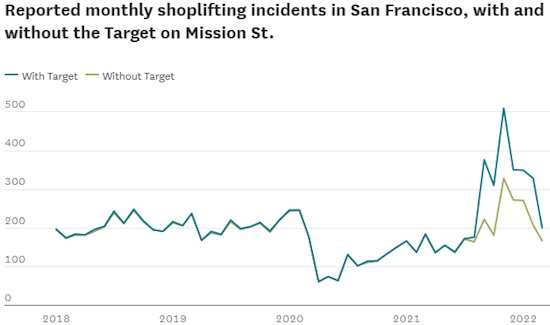Shoplifting Reported Crimes Skyrocketing With
Mission St. Target Leading the Way
San Francisco crime rates drastically shifted in the pandemic. These charts show
what’s happening now
In a recent
Bay Area Council poll of registered voters, a majority said the Bay Area was
not a safe place to live, an increase from prior years.
This public sentiment could soon drive political change: In a
separate poll
conducted by the same research firm,
nearly 70% of likely S.F.
voters said they would vote to recall District Attorney Chesa Boudin (June 7),
who ran on a platform of lowering the city’s jail population and seeking
alternatives to harsh sentences for lower-level offenders.
The Chronicle analyzed police incident data through March, comparing 2022 crime
rates with the first quarters of the previous four years. While police data can
be useful in measuring trends, it’s important to note
that it measures only reported
crimes, and thus may not accurately measure crime in the city.
The data shows that crime shifted dramatically during the pandemic. But now that
San Francisco is returning to pre-pandemic behavior, so are its crime rates — a
pattern in keeping with statewide trends.

Most property crimes are
returning to their pre-pandemic levels
Property crime trends have seen
the most dramatic changes in
San Francisco,
primarily because of the pandemic.
Burglaries, which spiked starting in mid-2020, have declined this year to their
pre-pandemic rates. Now that offices are reopening and people appear to be
returning to the city, burglary rates are getting back to normal.

But there’s an exception:
shoplifting, which spiked well above pre-pandemic levels this year.
That’s a continuation of an upward trajectory in San Francisco since late last
year.
Lofstrom said that the increase is in keeping with statewide trends, though San
Francisco’s rates appear to have decreased more than other cities initially and
increased more recently.
It’s important to note that lower-level crimes like larceny theft are
consistently underreported, so trends might not be perfectly reliable if the
amount of underreporting changes over time. For instance, much of the increase
in larceny thefts in late 2021 and early 2022 was due to an
increase in reported
shoplifting from a single Target store downtown (Mission St.).
Take away the Target and shoplifting rates look like they did in early 2018.

While many in the city believe
Boudin is responsible for changes in crime rates, for better and worse, research
suggests district attorneys typically have little impact on the crime rate.
Lofstrom said there is “no credible research pointing to a relationship between
D.A.s and broader measures of public safety, such as crime rates.”
sfchronicle.com
Key Moments in Boudin's Recall
- Coming June 7th
June 2021
Boudin catches
criticism for a
so-called
surge in shoplifting
after a spate of viral videos showing people running out of stores with armloads
of stolen goods. A Chronicle
analysis of San Francisco Police Department data finds shoplifting levels
remain below pre-pandemic levels.
Dec. 17, 2021
Breed declares a
state of emergency in the Tenderloin
after vowing to use police to clear the streets of people using drugs or people
who refuse shelter.
Boudin soon
criticizes the plan.
“We can’t arrest and
prosecute our way out of problems that are afflicting the Tenderloin,”
he said at a news conference.

&uuid=(email))



&uuid=(email))
